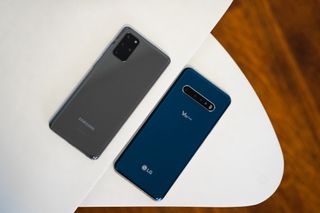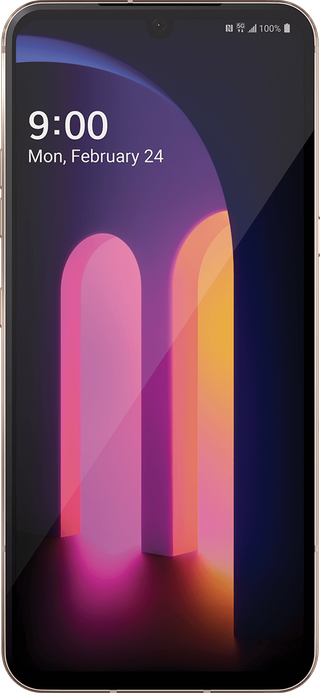Galaxy S20+ vs. LG V60 camera comparison: More isn't always better

There are few features more important in a modern smartphone than the cameras, particularly when you're spending somewhere in the ballpark of $1000 on your phone. The Galaxy S20+ is one of the top-ranking phones of early 2020, with excellent cameras and hardware, but its steep starting price of $1200 puts it out of reach for some consumers.
The LG V60 by comparison feels like a deal at "only" $900, and offers many of the same features — plus some bonuses like LG's excellent Quad DAC and a Dual Screen attachment. The cameras are comparable as well, with a similarly large main sensor and matching ultra-wide and time-of-flight sensors, though interestingly LG ditched the telephoto sensor this year.
We took both phones out and shot a variety of photos to see how each camera compares in different scenarios.
Daylight photos


Galaxy S20+ (left) / LG V60 (right) — click to view larger.








Broad daylight is rarely an issue with smartphone photography these days. The Galaxy S20+ touts a 12MP 1/1.76-inch primary sensor that's 65% larger than the sensor in last year's Galaxy S10. This allows the camera to take in more light and achieve better natural bokeh — this is especially evident in close-up shots like the flower photos above, where there's a clear, smooth separation between the foreground and background. Most phones feature a portrait mode that attempts to recreate this effect through processing and depth detection, but it's great to see such a pronounced result coming naturally from the main sensor.
Overprocessed images versus flat photos that almost require editing.
The LG V60 features a similarly large 1/1.72-inch sensor, and opts for a 64MP layout that uses 4:1 pixel binning to output sharper, brighter 16MP photos. There are pros and cons to using smaller or larger sensors, but both phones get great-looking results in good lighting. As you might expect, the S20+ leans into Samsung's tendencies of high contrast and saturation, and the V60's shots look positively dull by comparison.
That's not necessarily a good thing, though. Samsung's image processing often goes too far, with LG's more toned-down look actually more closely reflecting reality. My preference lies somewhere in the middle; I think the V60's muted look is easier to work with in editing software like Lightroom, and I think it generally does a much better job at handling true whites in shots, but the S20+'s bold colors likely appeal more to casual photographers, with a more Instagram-ready look straight out of the camera.
Be an expert in 5 minutes
Get the latest news from Android Central, your trusted companion in the world of Android








Color preferences aside, one major disadvantage of the S20+ that stood out to me while shooting in broad daylight was just how badly it suffers from lens flare; it's especially noticeable in the shots of the purple flowers and the Reggie Miller Mural. The V60 fared much better against lens flare, but in exchange, the photo of the Reggie Miller Mural is incredibly washed out, losing any shadow and color detail.
Low light photos


Galaxy S20+ (left) / LG V60 (right) — click to view larger.


Low light is a back-and-forth, as well. In auto mode, the V60 captured more detail in the shot above than the S20+, with more legible text on the clock and clearer detailing in the flooring and chair — but it casts a nasty yellow tint over the entire image, and lifts the highlights a bit too much. You can see the difference in how my LED moon sign is exposed with each phone; the S20+ does a much better job at retaining the outline of the light, while the V60 blows it out almost entirely.
Switching over to night mode, I think the S20+ actually takes the lead. With each phone on a tripod, the S20+ took considerably longer to capture (3 seconds versus roughly 1 second on the V60), but while the end result is a darker photo, it's much more realistic. There's more fine detail in the chair, and once again it does a better job handling the outline of the moon LED. The V60 completely whitens the wall behind the chair, but it turns out there's an ambient purple light just out of frame — which is only evident in the S20 shot.
Ultra-wide photos


Galaxy S20+ (left) / LG V60 (right) — click to view larger.




It's hard to complain about the ultra-wide lenses on either phone. LG has long been an ultra-wide champion, taking great shots without much harsh barrel distortion, and Samsung has largely caught up with the S20's ultra-wide. Both take great shots, though again each manufacturer's image processing comes into play. The S20+ has a way punchier look, while the V60 generally goes for a flatter, brighter look with a focus on truer whites (evidenced in the shot of the Indy City Barbell wall).
Once again, the S20+ suffers pretty badly from lens flare at times, with an extreme case shown in the Reggie Miller Mural shot. There's also considerably stronger haloing around buildings in the S20+ shots, though if you really pixel-peep, you'll find it present in both cameras.
Zoom photos


Galaxy S20+ (left) / LG V60 (right) — click to view larger.




Here's where the Galaxy S20+ really takes a lead. You might not get the same crazy periscope setup and "Space Zoom" of the S20 Ultra here, but the S20+ is still equipped with a 64MP telephoto lens that combines a native 3X reach with up to 10X of digital zoom for a combined 30X compared to the main sensor. The V60, by contrast, doesn't feature a telephoto camera at all, instead relying solely on digital zoom with its primary sensor.
It's well-equipped for digital zoom, since the V60's 64MP main camera gives it plenty of additional data to crop in on, and it actually holds up fairly well against the S20+ at up to 3X; in fact, 2X images often look better coming from the V60 since it has more resolution to work with on the main sensor. But once that telephoto camera kicks in, there's just no comparison.



Galaxy S20+ — click to view larger.




Just as 100X isn't actually practical on the S20 Ultra, 30X shots on the S20+ generally aren't terribly useful; photos turn out soft and colors start to spill into one another. But having all of that extra headroom means that 5X and even 10X shots are easily doable on the S20+. At 10X, you can clearly make out details on the face of the Shriners Emblem that's completely unintelligible in the wide shots from the daylight photos section.
Those facial details are much softer on the same shot from the V60, and there's a ton of grain introduced from that much digital zoom. On the S20+, you don't see those same effects until reaching all the way up to 30X.
Selfies



Galaxy S20+ (left/center) / LG V60 (right) — click to view larger.
Finally, if you're a big selfie taker, the V60 definitely won't be for you. While both phones feature 10MP front-facing cameras, selfies from the V60 are inexplicably devoid of facial detail. The sample above almost looks like an out of focus shot at first glance, but all of the details around my face are fairly intact; the bricks on the building behind me are clear, as is the texturing on my hoodie, and even the text on the pictured signs is fairly legible.
On selfies from the S20+, those same details are just as clear (though with a bit of extra background blur), but my face is much clearer, and my mask isn't totally blown out. You also get the added bonus of an optional wider shot for fitting more people in the frame during group selfies.
So which camera is better?
Overall, both phones take excellent photos, but I think the Galaxy S20+ is the more versatile photo tool. While I don't always love Samsung's hyper-processed, high-contrast image processing, the inclusion of both wide-angle and telephoto cameras allow you to confidently shoot in more scenarios, and I love the natural bokeh that comes with the main sensor.
That doesn't mean you should rule out the V60 entirely, though. It holds its own against many of the S20+'s shots, faring much better against harsh lens flare and typically producing more natural colors. You won't get the same far-reaching telephoto lens, but digital zoom up to 3X is perfectly serviceable on the V60, and LG's flatter image processing leaves you more flexibility for post-processing.

The most versatile shooting options
Samsung's overprocessed look isn't for everyone, but the combination of wide, ultra-wide, and telephoto cameras means that you'll be able to shoot great photos in virtually any scenario. Combined with digital zoom, the telephoto lens can reach up to 30X, and the main sensor has fantastic natural bokeh.

Less susceptible to lens flare and oversaturation
The V60 lacks a telephoto camera, but takes excellent photos with balanced colors and fewer problems in harsh daylight. The wide-angle lens is excellent, as are LG's manual video controls, and you can still pull off fairly impressive long-range photos with digital zoom.
Hayato was a product reviewer and video editor for Android Central.
